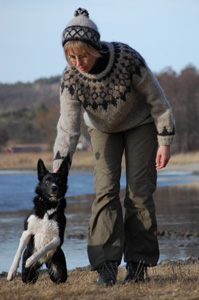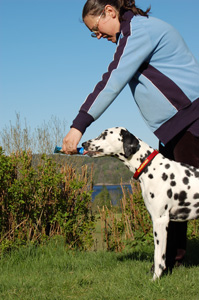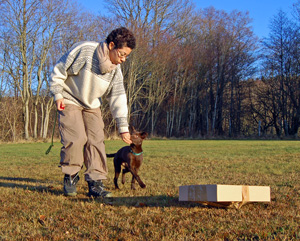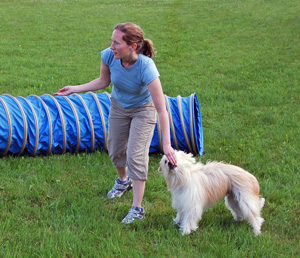Keeping a dog busy during transitions
For many years, we have preached about the importance of training according to Good Agility Practices. What that means is making sure that training is permeated by focus and intensity, and that your handling system is followed both during and in between exercises. This philosophy of training is not only true for agility training, but provides benefits for all kinds of training.
Maintaining focus and intensity while a dog is working actively is often quite easy—the dog is working to get his reward, and the trainer/handler is prepared to reward when the dog has completed the task at hand. But it can be a lot harder for both dog and handler to find a way to work with focus and intensity in the intermissions that are part of a training session. For example, when you want to move to the correct spot to begin an exercise, when something goes wrong and you need to start over, or when you simply need a few seconds to catch your breath, focus and intensity are tough to sustain.

Enter transports
This is where transports come into the picture. The point of transports is to bridge time and space:
- A transport can move your dog from point A to point B.
- A transport can keep your dog occupied during a stretch of time.
Experience has shown us that using a transport is something that most people "just do." You lure the dog to move with you, you lead the dog by his collar, you ask the dog to walk at your side or to lie down and wait for a while. However, these transports often create some confusion. The trainer may be unclear, and the dog may become a little confused, unsure, and/or frustrated.
We recommend that you train a number of different transports, the same way that you train other skills. When you train transports, both you and your dog know what to do, and all the whimsical time gaps disappear. We also recommend that you plan for your transports just as you plan for criteria and rewards. Transports that work make training easier and more fun!
Different kinds of transports
There are many possible means of transport. Here is a list of the ones we use the most:

Licking from a TreatToob—
a great treat magnet!
- The treat magnet—You have a treat in your hand, and your dog has his nose to your hand, simply following the treat.
- The tug—You're holding one end of the tug toy, and your dog is tugging on the other end.
- Collar—You hold your dog's collar.
- The lift and carry—You lift and carry your dog, or your dog jumps up in your arms for you to carry him.
- The hand target—Your dog's nose targets your hand.
- The stay and recall—You ask your dog to stay, you move to where you want to be, and you recall your dog.
You can also use a kind of informal heeling as a transport, where your dog "velcros" to your side or dances around your feet. But, a word of warning about this method: If you use this transport, it has to be a very well-trained and active behavior. You also need cues that tell your dog when the transport begins and ends. We really don't want to see a dog that just politely walks next to his handler. In a transport, the dog should be totally busy, and the transport should have a clear-cut end.
When do you need a transport?
Transports can be used in the following situations to move your dog to a clever starting point and/or to give you (or your dog) a few seconds break:
- Going into an exercise
- In connection with a reward
- When something has gone wrong and you need to start over
- Leaving an exercise
The transport has to be black and white
Either your dog is being transported, or he's not. There is nothing in between! This means that if you're transporting your dog using a treat magnet, your dog's nose should be in contact with your hand at all times. If you're transporting your dog using a tug toy, you're playing with your dog the entire time (ideally, your dog is hanging on to the tug toy really well). If you're holding your dog's collar, you don't let go until it's time for your dog to get to work again. The whole point of a transport is to remove downtime. While transporting your dog, you'll have time to take a breather and consider what to do next—while your dog is fully occupied!
Every transport must have a clear ending
It's extremely important that the line between "transport" and "start working" is sharp, sharp, sharp! When the transport ends, your dog should be able to begin working again. In order for your dog to know what to do, you must decide on the rules and stick to them.
This is how we end our transports:
- Treat magnet—The trainer distinctly and deliberately removes the hand with the treat (any leftover treats disappear).
- Tug—The trainer cues the release, and the dog lets go.
- Collar—The trainer lets go of the collar.
- Lift and carry—The trainer puts the dog down on the ground.
The hand target, the informal heeling, and the recall don't have endings of their own. We end them by transitioning into one of the other transports (for example collar or tug), or by giving the dog another cue (for example "sit" or "crate").
In other words, the transport is ongoing until you end it. For example, if your dog leaves the treat magnet or the tug toy to get back to work, that is a broken start! Get your dog back on the treat/toy again, and make sure that you are the one ending the transport. When you are holding on to your dog's collar or using the lift and carry, it's obviously your responsibility to hold on until you actually want to end the transport.
What should your dog do when the transport ends?
Usually, we want the dog to begin offering behaviors spontaneously as soon as the transport ends, just as we want the dog to begin working again as soon as a reward is over. If we're working on the weaves and we're using tug as a transport, the dog will drive toward the poles as soon as he's released from the toy. It's important for us to have spontaneous starts from our transports because we want to work with a dog that offers behaviors!
But sometimes you want a more controlled start, where the dog waits for a start cue before beginning to work. In these cases, the transport has to end with some form of cue that tells the dog to wait for the start cue. We use two different kinds of cues for waiting when the transport ends:
- The "parked dog" cue—If the dog has "frozen" in a still position when the transport ends, he should stay there until he gets his start cue (easiest from collar or lift and carry).
- Verbal cue—If the trainer cues a sit, wait, or attention just as the transport ends, the dog should perform that task straight away.
Naturally these cues have to be well-trained before you can use them at the end of a transport!
What's most important is that you know the rules. You can have different rules for different transports if you like. For example, you might have a rule that your dog should begin to work straight away out of a treat magnet, but a rule that your dog should transition to an informal heeling and wait for a start cue after tug. As long as you're consistent with your rules so that your dog knows what's expected of him, the rules will work.
Real-life examples
The examples below are taken from working with the weave poles in agility.

Using a treat magnet to get to a good
starting point close to the wobbly board
Example 1: Tug to a good starting position (in other words, to a place where both dog and trainer are facing the entrance). The trainer cues the release, and the dog lets go of the tug toy and drives toward the poles.
Example 2: Tug to a good starting position. The trainer grabs the collar (the tug transport is still ongoing), cues the release, holds on to the collar, and waits until the dog is standing completely still and balanced (the dog is "parked"). The trainer then lets go of the collar, waits until the dog looks toward the weave poles, and then gives the start cue. The dog drives toward the poles.
Example 3: Treat magnet to a good starting position, where the dog's nose is in the direction of the poles. The trainer distinctly removes the treat magnet and the dog drives toward the poles.
Example 4: Informal heeling to a good starting position. The dog gets a treat as the trainer grabs his collar. Trainer and dog move toward the poles, the dog aims toward the entrance, the trainer lets go, and the dog drives towards the poles.
Remember that the transport should last the entire distance to the next starting point. When the transport ends, you can't adjust to get the dog to the correct place. All of that must be accomplished during the transport!
Transports from a reward to a new starting point

A collar transport helps the
dog focus on what is still ahead.
Most transports occur in connection with rewards. The easiest way to get to a new starting point for the next repetition is simply to let the reward last a bit longer. For example, let's say that you reward using a thrown toy after the weaves. Your dog returns with the toy and you tug back to the next starting point. Letting the reward last longer, long enough that it lasts until the dog is in the right place to continue working, makes an enormous difference for focus and intensity—for both you and your dog!
If you move in a way that fits with your system of handling (for example pointing your shoulders in the direction your dog should be working), you'll make it easy for you both when you get back to work. Remember that you decide when the reward/transport ends! If your dog wants to jump the gun and get back to work again instead of continuing to play tug or to stay with the treat magnet, think of Premack. In that moment, work consists of "eat treat/play tug," and "get to work" is the reward. The dog gets to work (in other words, you end the transport) when the dog is attached to the transport tug or treat magnet. The more-probable behavior works as a reinforcer for the less-probable behavior.
Transports in connection with mistakes
If something goes wrong and you need to start over, you may have to direct your dog to a new starting point. As often as possible we seek to create exercises where this isn't necessary; the very best option is for you and your dog to carry on if something goes wrong. For example, we work with the weave poles in what we call the Bermuda Triangle—three sets of four poles set in a triangle formation. If the dog is correct, he gets his reward. If he makes a mistake, we keep going to the next set. But moving on sometimes isn't possible. In those cases, when you need to move the dog to a new starting point, you need a transport.

Oops! Keeping the dog busy with a treat
magnet, the trainer can get back on track.
What works best most often is for the handler to get the dog and transport him to a new starting point. As an example, let's say you are working with an inexperienced dog and the flat tunnel, training him to run to a remote reward through the tunnel, and the dog simply runs past the tunnel. Or, let's say you are working on the very end of the contacts, and the dog's rear end falls off. In either case, get your dog, by the collar or with a treat magnet, and transport both of you back to the starting point.
In other situations you might need your dog to come to you. Handle your dog to you (in accordance with your system of handling) and either handle back into the exercise again, or—if you need a break or/and to place your dog at a certain starting point—"catch" your dog in a transport. Take your dog's collar as he comes to you, or let your dog stick to a treat magnet, or present a hand target. The most important thing is that your dog knows what to do. You don't want any kind of gap. If your dog isn't working actively, he should be in transport, kept occupied, and/or held on to.
"But, I can't really use a treat magnet if my dog has made a mistake. That would be rewarding the mistake, wouldn't it?"
Well, you don't have to use your dog's favorite treat! You can use kibble for the transports that follow mistakes, and reward the correct behavior with pancakes or meatballs. You don't have to whoop it up and party during a transport. Experience tells us that you don't have to worry much about this. As long as you reward your dog well for the correct behaviors, your dog will choose behaviors where the consequence is a great reward rather than choosing a behavior where the consequence is a "nice but not fabulous" transport to a new starting point.
Breaks and transports
If you need to take a shorter break (maybe just to catch your breath), let your dog hang on to his tug toy or treat magnet, or hold on to his collar. For longer breaks, you need a station for your dog. We prefer a crate or a blanket. When you're ready to get back to work, either release your dog or go and get him, but make sure that he's kept occupied straight away. For example, your dog may hang on to his tug toy so that you can transport him to a good starting point for the next exercise.
Trained transports triumph!
Train your transports! In order for a transport to work, your dog must appreciate it (being held by his collar or being lifted and carried, as examples). Your dog must be able to hang on to his treat magnet or toy until you end the transport—even with distractions around him. When these behaviors are trained to be reliable, you can use transports to cut out downtime and gaps and to create training sessions with maximum flow and intensity.
Editor's note: This article was originally published in Clean Run magazine. Reprinted by permission.
Related Products
|
|
|





Post new comment